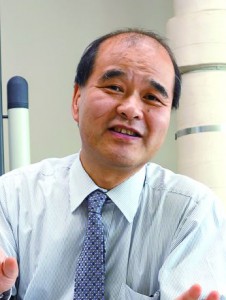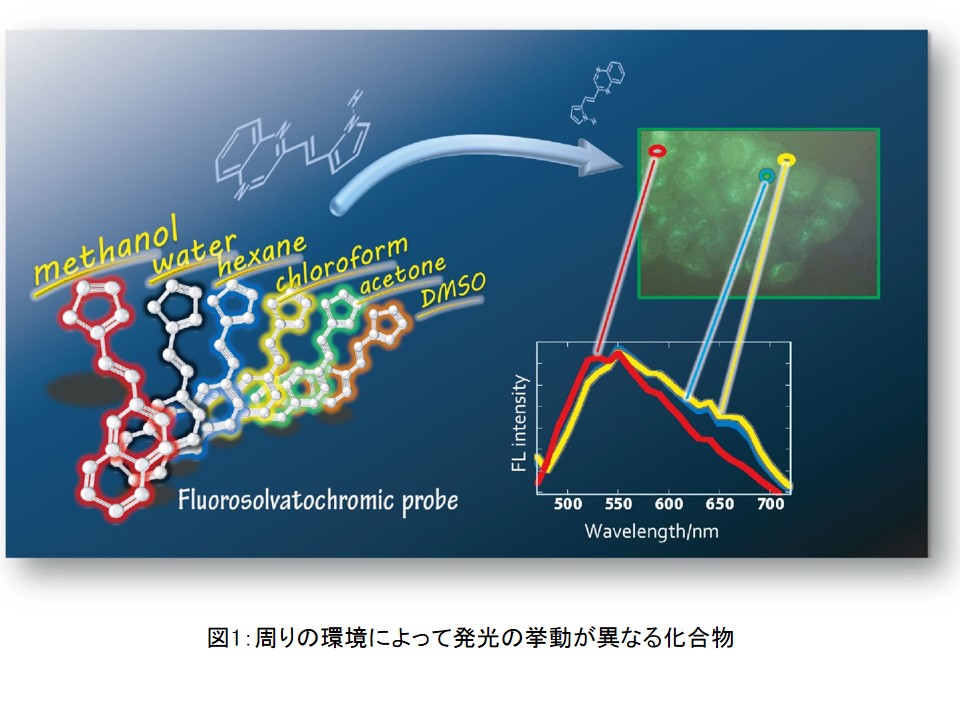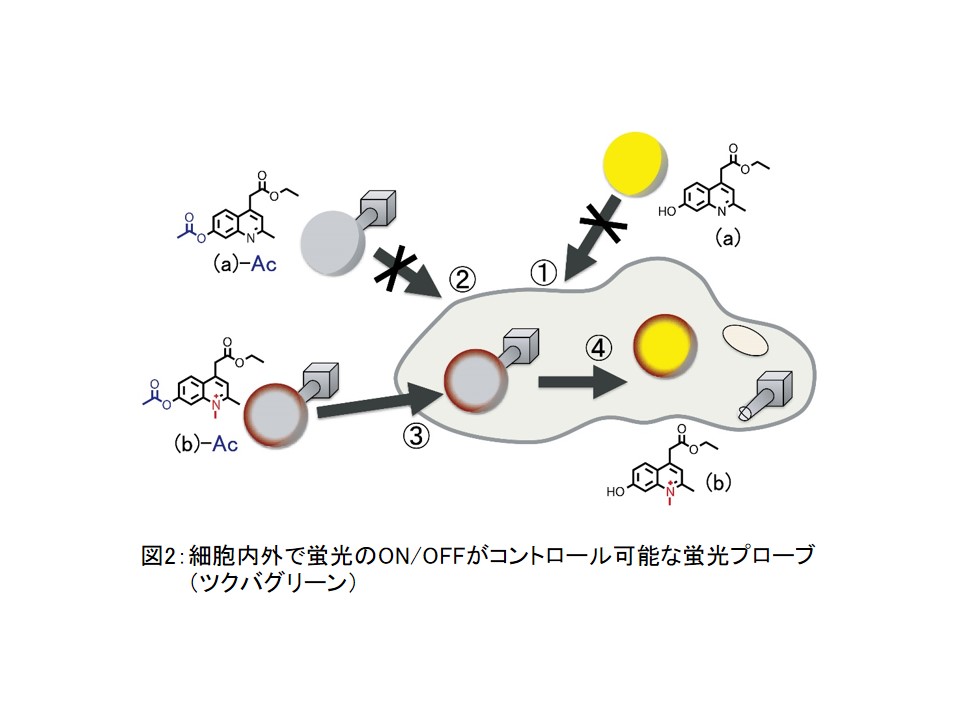キーワード:光化学、蛍光、バイオイメージング、機能性分子、分子集合体
http://www.chem.tsukuba.ac.jp/arai/
 21世紀は“光の時代だ”と称されるように、光のエネルギーを使った化合物の変化・反応制御に注目が集まってきています。化学の研究内容は、①化合物をつくる、②作った化合物の物性・機能・反応性を調べる、③構造を変化させる、④作った化合物を有用なことに利用する方法を検討する、の4つに大別することができますが、現在はとくに、毒性が低い、感度が高いなどの光の特性を生体の可視化に活用すべく世界中で研究開発が行われています。最先端の分子合成技術と分光学的特性の解明を融合させた「最先端分子によるバイオイメージング」リサーチユニットでは、つくば発“生体イメージング分野の開拓”に挑戦しています。
21世紀は“光の時代だ”と称されるように、光のエネルギーを使った化合物の変化・反応制御に注目が集まってきています。化学の研究内容は、①化合物をつくる、②作った化合物の物性・機能・反応性を調べる、③構造を変化させる、④作った化合物を有用なことに利用する方法を検討する、の4つに大別することができますが、現在はとくに、毒性が低い、感度が高いなどの光の特性を生体の可視化に活用すべく世界中で研究開発が行われています。最先端の分子合成技術と分光学的特性の解明を融合させた「最先端分子によるバイオイメージング」リサーチユニットでは、つくば発“生体イメージング分野の開拓”に挑戦しています。
異分野研究者チームで光化学の技術・知識を生体イメージングへ応用する
細胞膜の形やそのなかにある細胞小器官の分布、たんぱく質の機能などを、細胞が生きている状態で観察するには、装置の技術開発や観察手法の改良などだけでなく、高感度かつ空間・時間的な分解能が高い新規標識物質の開発が必要不可欠です。化合物のなかには周りの環境によって発光の挙動が違うもの(図1)や、 非線形光学現象*1を示すものなどもあります。本リサーチユニットは、学内外の化学・生物学・医学分野の研究者の協力のもと、光化学の技術・知識を生体イメージングに応用すべく異分野の研究者が協力し研究を実施しています。その過程で、発光のON/OFFを制御できる生体イメージング分子「ツクバグリーン」(新規蛍光色素)(図2)を開発し、結果を英文誌に報告しました。
*1:強い光と媒質(medium)との相互作用によって生じる非線形な光学現象の総称。
与えた光の整数倍の周波数の光が放出される光高調波発生などが代表的。


最も重要なことは、何を研究するか
「化合物を生体イメージングに使う」と簡単に言いますが、最も重要なことは、“何を研究するか”ということです。つまり、標識分子自体の機能性や反応性に興味がある化学分野の研究者と、標識分子をツールの一つとして認識している医学・生物学分野の研究者が、お互いにメリットのある共同研究を一緒に考える、 この作業を欠くと共同研究は成功しません。本リサーチユニットメンバーは、長い時間をかけて互いの信頼関係を構築してきました。この財産を基盤に、つくば発の新しい生体イメージング色素の開発と生体イメージングの新たな展開にいままさに挑戦しています。
社会への貢献・実績
● ツクバグリーンの開発
● 第二高調波発生用イメージング色素の開発
● 異分野の研究者間の交流の中核としての機能
(取材:平成25年6月6日)
A New Era of Light at Tsukuba
Unit members : Kuwabara, Junpei Kanbara, Takaki Nishimura, Yoshinobu Momotake, Atsuya
Key words: Photochemistry, fluorescence, bioimaging, functional molecules, molecular assembly
The 21st century is referred to as the “era of light.” The modification and reaction control of compounds using light energy are attracting attention. Chemical research is roughly divided into: (1) compound synthesis, (2) investigation of the physical properties, functions, and reactivities of the synthesized compounds, (3) modification of compound structures, and (4) utilization of the synthesized compounds. Currently, research and development are being conducted throughout the world to utilize optical  properties, such as low toxicity and high sensitivity, for biological visualization. The research unit “Bioimaging by frontier molecules” combines state-of-the-art molecular synthesis techniques with spectroscopic properties, promoting the “development of the biological imaging field” at Tsukuba.
properties, such as low toxicity and high sensitivity, for biological visualization. The research unit “Bioimaging by frontier molecules” combines state-of-the-art molecular synthesis techniques with spectroscopic properties, promoting the “development of the biological imaging field” at Tsukuba.
Photochemical techniques and findings are applied to biological imaging by a team of researchers from different fields
To observe cell membrane structures, organelle distribution, and protein functions in living cells, equipment-based techniques and observation methods should be improved, and novel labeling substances with high sensitivity and high spatial and temporal resolution should be developed. Some compounds show light-emitting behaviors that change with the surrounding environment (Figure 1) or non-linear optical phenomena*1. Our unit is applying photochemical techniques and findings to biological imaging in collaboration with researchers in the fields of chemistry, biology and medicine inside and outside the university. Meanwhile, we developed a novel biological imaging molecule, “Tsukuba-green” (novel fluorescent dye), that can turn on and off light emission (Figure 2), and reported our results in an English journal.

Figure 2: Fluorescent probe “Tsukuba-green” that can turn on and off fluorescence inside and outside cells
*1: Generic name of non-linear optical phenomena caused by interaction with a strong light and medium, represented by optical harmonic generation emitting light with a frequency that is an integer multiple of that applied
What should be investigated?
Using compounds for biological imaging is not easy. Research objectives are critical. Specifically, chemists who are interested in the functionality and reactivity of labeled molecules and researchers in medical and biological fields, who recognize the usefulness of labeled molecules, should plan joint research beneficial to both parties. This is indispensable for successful joint research. The unit members have established a partnership over a long time. Based on this, we are trying to develop novel biological imaging dyes and biological imaging techniques at Tsukuba.
Social contributions and achievements
● Development of dyes for second harmonic generation imaging
● Function as the core for the exchange of researchers from different fields

